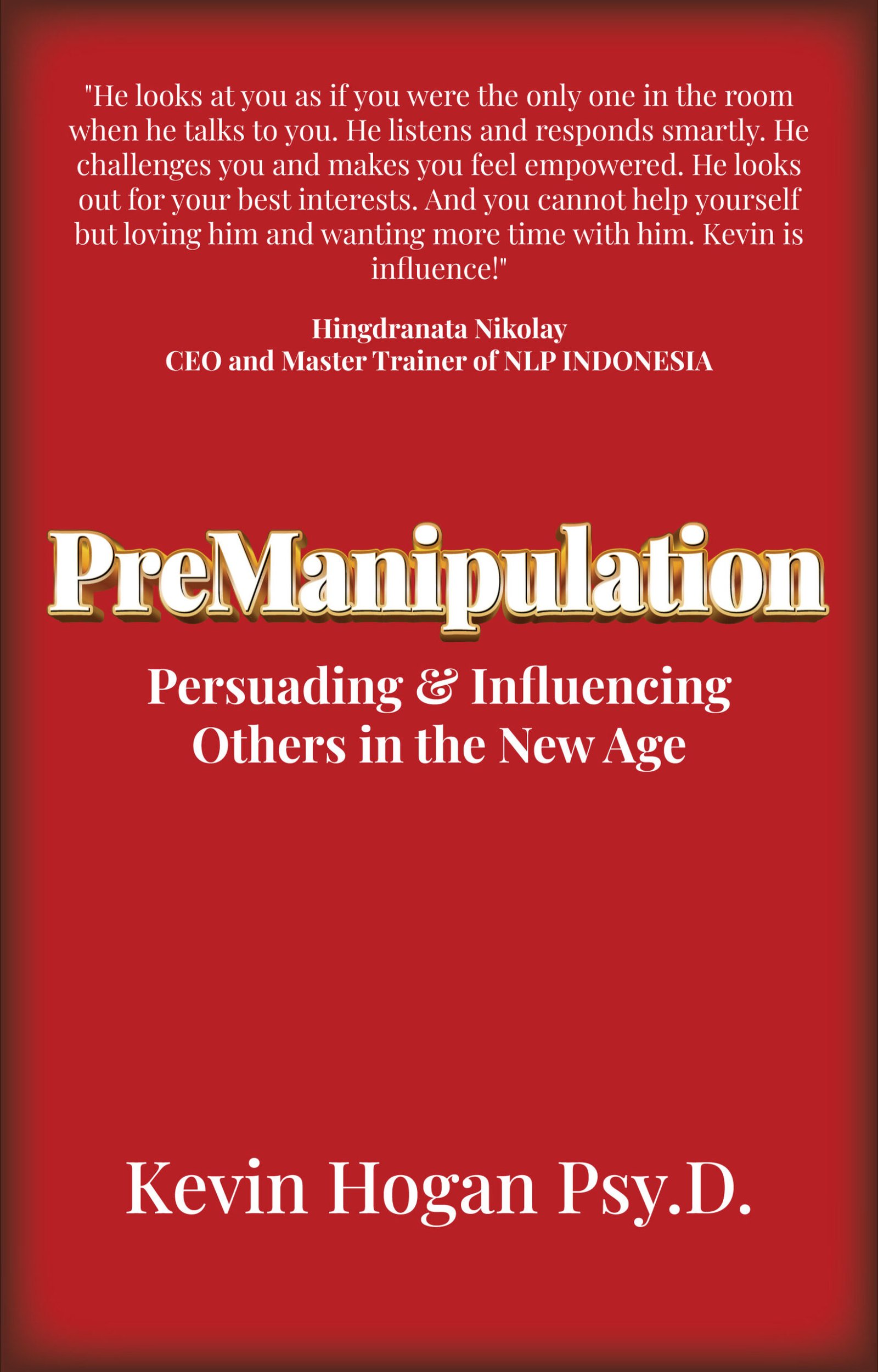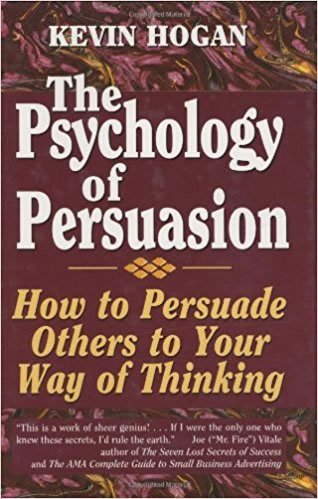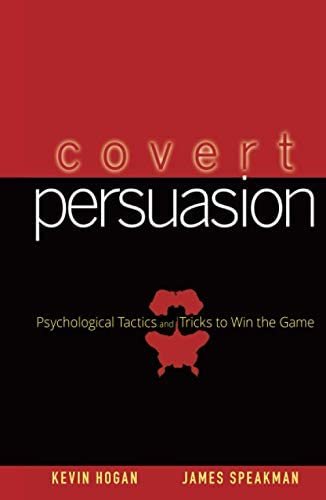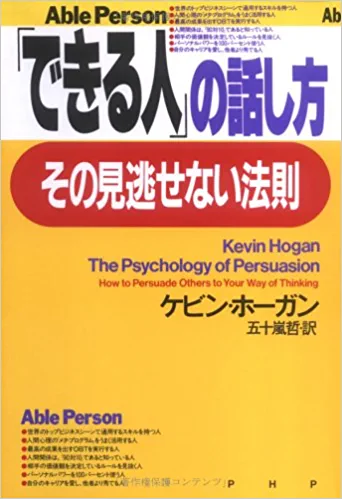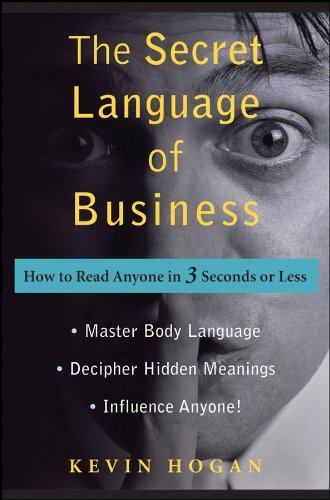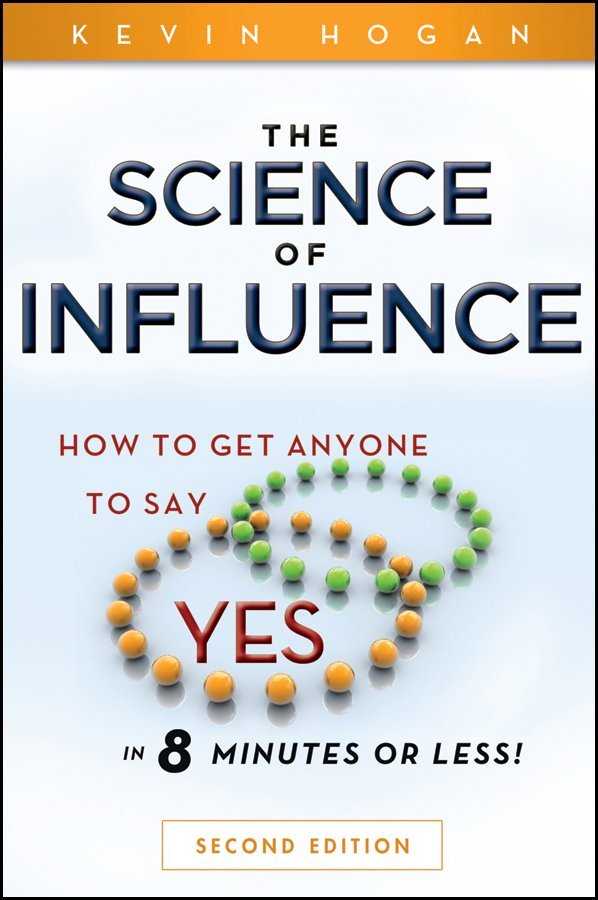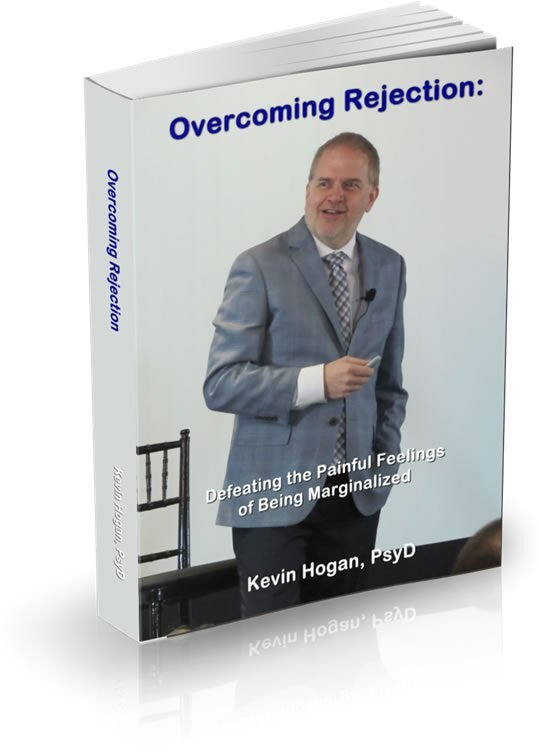Persuasion subroutines Part One
You’re about to go where very few have ever gone before…
I’ve been wanting to give you some real in-depth perspectives at determining in advance what will cause any given person to be persuaded in any given encounter.
Perhaps more importantly, I’ve been wanting to show you how to know when you are wasting your time delivering a message when the receiver isn’t tuned in to you.
You’ll quickly see why most people are impotent in their persuasion efforts and you’ll get an introduction to how persuasion works inside the brain. Understanding what happens inside takes you a long way to being optimally effective.
Over the last few weeks, I’ve introduced you to subroutines in the brain and how they control most of what people do. Today, you dig in deeper to see the actual processes as they operate in the brain and what has to happen for you to cause change in their behavior or get them to say “yes.”
Most of the subroutines running in your brain are built, or more precisely, grow, over time. You can think of them as parts or ego states, although the concept of parts/ego states is not as precise or eloquent as the notion of subroutines.
For introductory purposes, either metaphor is probably fine as long as the metaphor helps you navigate self and other regulation. That means you know how to control your Self and direct the behavior of other people, which isn’t quite the same as controlling others, an experience that rarely ends up well!
Here’s a quick thumbnail about how subroutines develop and how you can take advantage of subroutines’ strengths and weaknesses when persuading.
You Are Born Pre-Programmed
You were born with genetic predispositions. Those predispositions are manifest in behaviors that are modified by external and internal stimulus and the responses to those repetitive stimuli.
Example: Like most (but not all) humans, you are born with the drive to fight or flee from danger. The drive is not a subroutine. Drives fuel behavior, thoughts, emotions and actions as they interact with the environment and other people.
 Now, imagine a teen at school today coming up on a class where he is slated to give a 10-minute speech. The teen is terrified to give the scheduled presentation. He has the inborn instinct to act by fighting or fleeing from that which he is terrified. Today, the teen won’t use self control/self regulation but will yield to his gut reaction. Manifestation? Today he will skip class. (Flight) He could also get himself in trouble with the teacher or anyone else that morning and end up in the principal’s office. (Fight) In either case, the brain/gut has taken care of the individual by doing what it is biologically programmed to do. It follows the instincts it is born with, then triggers the subroutine to fulfill its mission. Instincts have been shaped by behavior.
Now, imagine a teen at school today coming up on a class where he is slated to give a 10-minute speech. The teen is terrified to give the scheduled presentation. He has the inborn instinct to act by fighting or fleeing from that which he is terrified. Today, the teen won’t use self control/self regulation but will yield to his gut reaction. Manifestation? Today he will skip class. (Flight) He could also get himself in trouble with the teacher or anyone else that morning and end up in the principal’s office. (Fight) In either case, the brain/gut has taken care of the individual by doing what it is biologically programmed to do. It follows the instincts it is born with, then triggers the subroutine to fulfill its mission. Instincts have been shaped by behavior.
Later, he’ll be asked to explain why he skipped class and he’ll almost certainly feel compelled to lie.
The act of lying or deceiving, if you will, in defense of irrational behavior is a subroutine. It has thousands and thousands of experiences and causes the person to behave in a fashion that does damage control.
Admitting you’re afraid of being thought stupid because of presenting in front of a room is fear-generating in itself.
Persuasion question: If you asked someone to take an action while a subroutine to defend and deceive was processing, how might that change your conversation? How might it change the result of your requests? If you were the person (the stimulus) that triggered the deception subroutine what is likely to be the only result?
Spinning the wheel to a sub-routine you can influence?
 Persuasion doesn’t require the other person to be honest, but in most encounters, if you can spin a person to a subroutine that isn’t going to protect the individual by deception, you’re more likely to persuade the person to do something that is optimally valuable.
Persuasion doesn’t require the other person to be honest, but in most encounters, if you can spin a person to a subroutine that isn’t going to protect the individual by deception, you’re more likely to persuade the person to do something that is optimally valuable.
For the teen, the only long-term positive outcome happens when he exercises self-control and regulates the behavior. The only long-term positive outcomes occur when facing irrational fears and fighting them head on.
[Being certain to never confuse irrational (teddy bear) with rational (bear)…]
If you were sitting next to the teen before he was going to skip class, you might try to convince him to go to class by saying, “it will be OK…you’ll do fine.”
Even consciously, he knows better. You’ve now lied to him and that is a grand way to cause someone to bolt from you as he did from the class. You are now part of the problem. Persuading someone to overcome a fear has nothing to do with surface structure logic. That means you have to convince a subroutine that doesn’t speak. You can’t tell the person, “you’ll be OK, I promise. No one is going to die in there.”
See how ridiculous it sounds when you actually know what subroutine is running? People are always concerned about scripting their conversations whether they want to pick up the girl, get a raise, negotiate a deal or make the sale.
That’s why they want scripts.
Because the old scripts don’t work. They can’t work. They’ve never worked. They never will.
 While the teen is consciously interpreting the subroutine, he still hasn’t decided to cut class and save his soul. At this point, you can speak right to the interpretation of the subroutine.
While the teen is consciously interpreting the subroutine, he still hasn’t decided to cut class and save his soul. At this point, you can speak right to the interpretation of the subroutine.
“That class is going to suck today. You’ve got to get up there in front of all those people, know that some of them are jerks and will probably make fun of you. Makes you want to smack them all around doesn’t it?”
You’ve now caused the teen to doubt his distrust of you and you have gained some trust points. That’s a modest accomplishment and it is tenuous at best until the teen actually is convinced you’ve proven yourself to his subroutines, which no longer see you as a stimulus that needs to be “dealt with.”
Drivers Lead to Sub-Routines
The flight/fight response is just one driver of behavior and it will give birth to a number of subroutines.
There are 15 other drives beyond flight/fight. Those that are typically most behavior-driving are the desire to eat and the desire to have sex/reproduce.
In some people, these first three drivers aren’t a specific individuals “core drivers” but are instead secondary.
In predicting behavior, you assume they are the foundation until you discover otherwise. There are still 13 other drivers. There is the drive to belong, the drive to acquire, the drive of curiosity and learning. People are driven by the desire for independence, altruism and revenge/competition, and a total of 7 other core desires.
What makes you and I different from each other is the fact that these 16 drivers are all manifest in different degrees and in different polarities in you and I. It isn’t simply a question of “how much independence” you want but whether you are driven toward independence or dependence, and *then* just how much.
The drive of acquisition (aka “the desire to acquire”) is thus manifest to the degree on one side of the spectrum as having no possessions or perhaps even people in their lives vs. another person who is driven to collect and even hoard things or people, on the other end of the spectrum.
Drives, Desires and Subroutines
Back to the teen in school.
This time the scenario will play out slightly differently.
 This time he does some further thinking himself.
This time he does some further thinking himself.
He is compelled to do anything to avoid giving a presentation. From the outside it simply looks like the teen doesn’t want to give the presentation. In reality, it’s much more dramatic than that. It’s a question of terror. His inner reptile is literally going to bolt or fight so that he doesn’t have to present material that day.
That part of the story is all the same.
Flight/fight is activated. His reptile is compelled to not give the presentation BUT in this scenario, the student has an equally or greater core driver “to belong.” Almost all humans have a drive to belong to some group(s).
Survival is almost impossible without belonging, so this driver can be a determining factor in what people ultimately do.
In this case, let’s imagine the student likes the teacher a great deal. They have excellent rapport. The student has few friends, but those he has are the kids he will be presenting to today. The presentation is part of a team presentation and the group he’s presenting with are his best and pretty much only friends. The student is now very likely to live with the terror and present because the fear of letting down his friends and being ostracized from his group would be greater.
The question of loyalty to the group could come up in your mind. Yes, loyalty to friends is significant, but the fear of being ostracized is far more compelling than a wish to be loyal.
Never misunderstand loyalty (an element of honor) and belonging. They are two different drives that can look the same on surface.
You will develop the skill of discernment as time goes on. You persuade each differently.
In the first scenario, our student skips class to avoid the presentation. The second scenario? The student with an equal amount of terror gives the presentation because of the over-riding drive to belong.
 Both situations are common in many different contexts of life.
Both situations are common in many different contexts of life.
People rarely take the time to even learn how to identify the 16 drivers that are pushing and pulling the people they interact with. After all, 16 is a monstrous number. 16 isn’t 7, after all. It’s a lot to think about. 😉
The upside in digging deep here is that people are predictably lazy and rarely take the time to learn the 16 drivers! People have no idea how to predict human behavior, viewing it as a mystery; and they have no idea how to change themselves or persuade others to change or comply with their wishes.
Effort required, yes?
You will always have the advantage of being able to predict behavior with startling accuracy. This is true of your behavior or the actions of others. It doesn’t take long to figure out what is pushing and pulling people. Once you have figured it out, it is, frankly, fairly simple to almost know what people will do in most situations.
If you personify a subroutine you observe, it’s easier to understand what the person wants to do and what they will likely do next while that subroutine is activated in the brain.
The most valuable insight you gain from delving into the 16 drivers is being able to see through the eyes of almost anyone. Specifically, people who are driven by specific combinations of drivers see the world in very predictable ways.
People who do not have the desire to acquire switched “on,” view others as greedy. People who have the desire to acquire turned “on” see others as people who are not prepared for the future. And that is simply one distinction of a half dozen or so, for each core driver.
And that means a lot more than you might think. When you can know what someone is thinking and why, there is little reason to ever communicate significant information to them that doesn’t comfort or trigger (in a useful fashion) their core drivers.
Behavior is directed (or controlled, gulp) by a message of greater importance to one’s most powerful drivers, squashing a slightly smaller driver. People often believe the core of these messages must be stated verbally, but that’s not typically the case. Vocal nuances will often do the trick. Utilizing questions, of course, is generally the most effective tactic.
Zeroing in on their Core Driver …
 “And the team is cool with you not presenting today?”
“And the team is cool with you not presenting today?”
That would normally be all it would take to “influence” the other person with a strong drive to belong, to give the presentation, assuming that was the best overall decision for the student.
Most of the world is trying to “figure out what to say” to someone to “persuade them” when really there’s nothing to figure out as far as words are concerned. The message matters a lot. The exact words are significant, but nothing compared to the delivery style.
If the teen was driven most potently by vengeance (competition/revenge) then, “And the team is cool with you not presenting today?” is obviously impotent.
Instead?
“So you are OK with the class thinking you can’t pull it off?”
or
“Aren’t they the same kids that picked on you…you seriously don’t want to show them who you are…”
Starting to make sense?
The message is the picture that ends up in the other person’s mind. If you try to script your communication instead of learn the other person’s drivers, you will only hear “yes” or get the change you want a very, very small percentage of the time. Perhaps 10%.
We’ll return to the quest for directing subroutines in a moment. A quick sidestep into ethics.
Persuasion = Communication
“Persuasion” has a connotation that “communication” doesn’t have. Without splitting hairs they are one and the same thing. The difference? People rarely communicate with intention. They tend to simply speak before thinking about the words and tones that are about to exit their mouth.
People who endlessly babble tend to say things like this:
“I’d never persuade someone to do something they wouldn’t want to do.”
That’s what a lot of babblers want to hear, but it really isn’t true.
The purpose of all communication is to influence. The babbler is attempting to influence that they are important. When the stream of words stops, they feel they have failed.
Just imagine for a moment: Can you think of any sentence you can say in a stated context that might not have a persuasive intention?
I’m sure there is some such construct somewhere, I’ve simply not found it yet.
The purpose of all persuasion (communication) is to cause a behavior or at least a thought or feeling in another, or a group of people, that the individual possibly wouldn’t have come to themselves.
 Most actions people take are done incorrectly and not in their own best overall interest. This is why it is easy to be a critic and not as easy to be effective. It is clearly in the teen’s best interest to override his subroutines, give the presentation, and receive a grade for his effort. If your influence can help him to do that, is it not considered the best thing all around?
Most actions people take are done incorrectly and not in their own best overall interest. This is why it is easy to be a critic and not as easy to be effective. It is clearly in the teen’s best interest to override his subroutines, give the presentation, and receive a grade for his effort. If your influence can help him to do that, is it not considered the best thing all around?
People grow fat, get diabetes, smoke until they get cancer, quit learning, join cults, make disastrous child rearing decisions, beat their spouses, rob banks, kill people on purpose and by accident, steal investors’ money, molest children, rape women, and on and on and on. People are walking decision disasters.
Why?
People do what their “gut” tells them to do. The power of making decisions by stomach sensation…
It’s that simple.
Guts don’t think. They just do stuff in impulse movements and rarely get real stuff done.
My job, hopefully your job in general, is to get people to do something other than what they “normally would do.” We want people to not rip off their banking customers, prefer them to not rape the woman next door, opt for other behavior than grand theft auto, choose something different than smacking the kids around. Normal behaviors are normally a disaster.
Digging in: What is behind “all” behavior?
All behaviors occur because of the influences of the interactions of drivers within the individual and within the group.
People hire me to get people to do what they don’t want to do. It’s typically the best thing to do and the thing I do best.
Returning to subroutines and shifting them into the right place…
The subroutines in humans aren’t literal computer programs. They are always a combination of the proverbial nature + nurture factors.
Stock behaviors, those behaviors that are off the shelf, those behaviors that are done by rote or routine, the same every single time, are very, very difficult to change. These are subroutines. Subroutines collect external stimuli and when “they hear” (“they” don’t really hear, but stick with me on this) ideas, notions, considerations that something other than their specialty behavior might be performed they “lock in to place” and fire up their defense mechanisms.
 They will skip class instead of being forced to do something they are terrified of.
They will skip class instead of being forced to do something they are terrified of.
Once a person has eaten 10 cookies per day, that’s 3650 cookies per year. That’s 36,500 cookies in a decade. That’s 100,000 cookies in less than 30 years. The stimulus/responses that take the person to the cupboard, get the cookies and cause them to be eaten is not something that is going to be solved by a scolding, 10 sessions of hypnosis, a drug or anything else that comes in a package.
It requires long-term persuasion.
100,000 is more than “a habit.” 100,000 is a veritable and literal program. It’s a subroutine. It requires no thought and generally, these kinds of experiences aren’t encoded into working memory. The cookies are eaten and if a written or video record isn’t made in that moment, the individual will certainly not remember eating the cookies. They get to the end of the cookie jar and then wonder where they all went.
“I can’t remember eating cookies!”
I can hear your brain all the way over here.
Me too.
You just can’t distinguish that memory from any other faint memory of a similar cookie eating experience. They are all the same and 99.9% of all cookie eating sessions are 100% “forgotten.” They never happened…until you run out and have to go to the store wondering who ate all the damn cookies…
That is a DEEP subroutine. A stimulus (and there can be MANY different stimuli that bring on the intake of cookies, for example) triggers a set of behaviors that end up in the eating of cookies.
You can now ask a few questions about causing behavior to change.
“How do I get him to stop eating cookies he doesn’t even recognize he has eaten?!”
“How do I get him to reduce the number of cookies he will eat each day?”
“How can I stop him from eating cookies TODAY?”
As you can guess, these changes aren’t going to happen easily. There is no technology to create a permanent change immediately, at least not one without daily self regulation involved. There is certainly no pill or brief therapy.
 In each case, a complete and comprehensive strategy must be planned and implemented.
In each case, a complete and comprehensive strategy must be planned and implemented.
Causing someone to stop eating 100,000 cookies will generally require that person to have compelling reasons and driving feelings well considered at a conscious level of thought, or, there will need to be a strong motivator on the outside that will squash the desire to eat.
Importantly, the eating of cookies is not always a response to the desire to eat.In fact, perhaps half of the time “hunger” has little to do with reaching into the cookie jar. Quite often it is pairing various stimuli with the undesirable behavior, assuming eating 10 cookies per day is undesirable.
Changing a habit can be about changing a desire driven subroutine, or it can be about changing a behaviorally shaped subroutine. In either case, the subroutine needs to be manipulated. (ouch)
There are lots of tactics that you can use to cause the person to change.
When is the only time a subroutine gets turned off?
Think about it.
You can remove the cookies from the house and all other places the person goes to. You send the person to Ethiopia and they will succeed at stopping the eating of cookies. Otherwise, removal of reward is only a fair tactic. It’s typically overcome by two legs, a wallet and a car.
In this case, it makes it impossible for the response piece of the equation.
 That subroutine will go to great lengths to complete the cycle of stimulus to final response. That means that the subroutine, against all rationale or logic, will drive to the store, sneak, hide or steal, doing whatever is necessary to get those cookies into the mouth.
That subroutine will go to great lengths to complete the cycle of stimulus to final response. That means that the subroutine, against all rationale or logic, will drive to the store, sneak, hide or steal, doing whatever is necessary to get those cookies into the mouth.
It sounds ridiculous. You’d think the brain would simply be OK with eating an apple or a donut when one of the various stimuli triggers the movements and actions to go for the cookies.
A substitute can work short-term, today, but the brain/body subroutine will work its way to the cookies no matter what city or state they are located in.
You can remove the object, but that doesn’t remove the desire.
Remember the girlfriend or guy that broke up with you?
When did that feeling of the need for reconciliation or reconnection go away?
Exactly.
When a subroutine is created, and it runs a big chunk of behavior day in and day out, it does its job and no other.
 People talk about stalking as if it is an unexpected behavior.
People talk about stalking as if it is an unexpected behavior.
It’s nothing of the sort. It is precisely what you would predict to happen when the brain has locked into another human. And it doesn’t take long for that to occur. Expect stalking behavior. Celebrities should anticipate being stalked. A beautiful girl should anticipate being stalked. Location, setting, context don’t matter.
Subroutines have a job to do and their job is to put the individual in the presence of another individual. When the subroutine has accomplished that outcome, it shuts off until the reward is once again removed.
“Stop texting/calling/messaging/emailing/peeking in my window at….me.”
Good luck with that.
Two legs, a wallet and a car.
Subroutines are turned on with a stimulus, like a light switch.
They are only turned off when the outcome has been acquired/achieved.
Can you reason with a subroutine? Would you want to?
Not Easily Switched Off
Subroutines that have been operating for lengthy periods of time can’t just be turned off. They can be changed over time. It takes a lot of planning, strategy and implementation.
- Can you talk to a subroutine?
- Can you reason with a subroutine?
- Can you talk to a “part” or “ego state”?
Subroutines don’t talk. They don’t think. They can’t be reasoned with, BUT they can be temporarily deactivated when another subroutine has stuff to do that is of greater importance.
Subroutines pursue an outcome they have chased and been rewarded by, thousands of times. Subroutines typically don’t stop working until the outcome is completed.
Have you seen the cars that will park on their own? Pretty amazing. That’s a subroutine. It can’t think. You can interrupt it, but you can’t talk to it or rationalize with it. It just does that one thing. When it’s parked, it’s done. It’s over. The subroutine shuts off until it is turned on to park the next time. Where does the analogy break down? The driver can override the system even after it has begun parking.
One way you stop the cookies from entering the body is by putting a stronger drive to work. Persuasion begins there.
Next week?
Let me know if this article changed how you see the world and persuasion and if it did, we’ll pick it up here next week.

